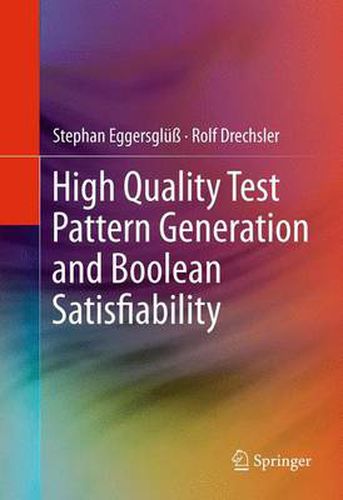Readings Newsletter
Become a Readings Member to make your shopping experience even easier.
Sign in or sign up for free!
You’re not far away from qualifying for FREE standard shipping within Australia
You’ve qualified for FREE standard shipping within Australia
The cart is loading…






This title is printed to order. This book may have been self-published. If so, we cannot guarantee the quality of the content. In the main most books will have gone through the editing process however some may not. We therefore suggest that you be aware of this before ordering this book. If in doubt check either the author or publisher’s details as we are unable to accept any returns unless they are faulty. Please contact us if you have any questions.
This book provides an overview of automatic test pattern generation (ATPG) and introduces novel techniques to complement classical ATPG, based on Boolean Satisfiability (SAT). A fast and highly fault efficient SAT-based ATPG framework is presented which is also able to generate high-quality delay tests such as robust path delay tests, as well as tests with long propagation paths to detect small delay defects.
The aim of the techniques and methodologies presented in this book is to improve SAT-based ATPG, in order to make it applicable in industrial practice. Readers will learn to improve the performance and robustness of the overall test generation process, so that the ATPG algorithm reliably will generate test patterns for most targeted faults in acceptable run time to meet the high fault coverage demands of industry. The techniques and improvements presented in this book provide the following advantages:
Provides a comprehensive introduction to test generation and Boolean Satisfiability (SAT);
Describes a highly fault efficient SAT-based ATPG framework;
Introduces circuit-oriented SAT solving techniques, which make use of structural information and are able to accelerate the search process significantly; Provides SAT formulations for the prevalent delay faults models, in addition to the classical stuck-at fault model; Includes an industrial perspective on the state-of-the-art in the testing, along with SAT; two topics typically distinguished from each other.
$9.00 standard shipping within Australia
FREE standard shipping within Australia for orders over $100.00
Express & International shipping calculated at checkout
This title is printed to order. This book may have been self-published. If so, we cannot guarantee the quality of the content. In the main most books will have gone through the editing process however some may not. We therefore suggest that you be aware of this before ordering this book. If in doubt check either the author or publisher’s details as we are unable to accept any returns unless they are faulty. Please contact us if you have any questions.
This book provides an overview of automatic test pattern generation (ATPG) and introduces novel techniques to complement classical ATPG, based on Boolean Satisfiability (SAT). A fast and highly fault efficient SAT-based ATPG framework is presented which is also able to generate high-quality delay tests such as robust path delay tests, as well as tests with long propagation paths to detect small delay defects.
The aim of the techniques and methodologies presented in this book is to improve SAT-based ATPG, in order to make it applicable in industrial practice. Readers will learn to improve the performance and robustness of the overall test generation process, so that the ATPG algorithm reliably will generate test patterns for most targeted faults in acceptable run time to meet the high fault coverage demands of industry. The techniques and improvements presented in this book provide the following advantages:
Provides a comprehensive introduction to test generation and Boolean Satisfiability (SAT);
Describes a highly fault efficient SAT-based ATPG framework;
Introduces circuit-oriented SAT solving techniques, which make use of structural information and are able to accelerate the search process significantly; Provides SAT formulations for the prevalent delay faults models, in addition to the classical stuck-at fault model; Includes an industrial perspective on the state-of-the-art in the testing, along with SAT; two topics typically distinguished from each other.